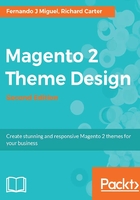
Blocks and pages in Magento
Magento uses blocks to differentiate between the various components of its functionality, the idea being that this makes it easier for Magento developers and Magento theme designers to customize the functionality of Magento and the look and feel of Magento respectively.
A content block displays the generated HTML provided by Magento for any given feature. Content blocks are used within Magento structural blocks. Examples of content blocks in Magento include the following:
- The search feature
- Product listings
- The mini cart
- Category listings
- Site navigation links
- Callouts (advertising blocks)
Simply, content blocks are the what of a Magento theme: they define what type of content appears within any given page or view within Magento.
Usually, the blocks are available in a visual hierarchy from a page. A typical structure of a three-column block in a Magento theme includes the following:
- Header
- Primary area
- Left column
- Right column
- Footer

Magento has a flexible theme system. Beyond Magento code customization, the admin can create blocks and content on the Magento admin panel such as Home page and About Us; any static page that you want to create. CMS (Content Management System) pages and blocks on Magento give you the power to embed HTML code in your page.
You can create or edit pages and blocks by accessing the Admin area (http://localhost/packt/admin_packt) and navigating to Content | Pages:
